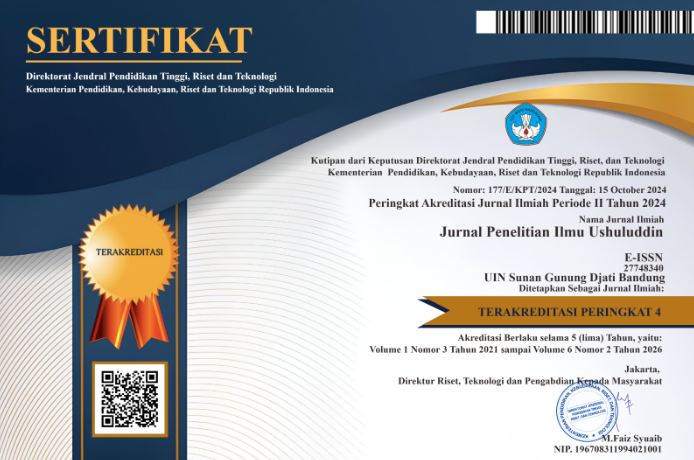Hadits tentang Dzikir Perspektif Tasawuf
DOI:
https://doi.org/10.15575/jpiu.13583Keywords:
Dhikr, Hadith, Syarah, SufismAbstract
The background of this research is that dhikr in the hadith of the Prophet SAW has an attachment to other teachings, such as dhikr and Sufism. Dhikr and Sufism are seen as a medium of communicating with Allah SWT to know and be closer to Him and make the heart and soul calm and noble. This study aims to discuss the hadith about dhikr in the perspective of Sufism. This research is a qualitative type through literature study with the method of syarah hadith and analysis of Sufism. The results and discussion show that dhikr can revive the heart from death, namely a heart that does not remember the greatness of Allah SWT, this is in accordance with the hadith of the Prophet SAW from Abu Musa Asy'ari that the parable of a person who makes dhikr and someone who does not remember Allah is like a person who remembers Allah live with the dead. This study concludes that the hadith about dhikr according to the review of the hadith syarah with the analysis of Sufism is recommended for dhikr to Allah SWT continuously (mudawammah), because with dhikr, can revive the heart from death. A heart that does not remember the greatness of Allah SWT considered dead by the Sufis. This study recommends to Islamic religious authorities, in order to provide an understanding to the Muslim audience regarding the syarah hadith about dhikr from the Sufism perspective.References
Ahmad, M. (2015). Zikir sebagai media komunikasi. Jurnal Dakwah Tabligh, 16(1), 90-97.
al-Ghazali. (1994). Minhaj al-Arifin, dalam “Majmu ar-Rasa‟ilâ€. Beirut: Dar Al-Kutub Al-ilmiyah,.
al-Ghazali. (1999). Asrar al-Adzkar wa ad-Da‟awat. Bandung: Karisma, .
al-Hujwiri. (1992). Kasyf al-Mahjub, terj. Bandung: Mizan.
al-Islam. (1987). Muamalah dan Akhlak . Jakarta: PT. Rineka Cipta.
al-Maraghi, A. M. (2001). Tafsir al-Maraghi, Jilid 23. Beirut: Dar al-Fikr.
al-Sakandari, I. '. (2003). Jakarta: Zaman.
Amini, I. (2002). Risalah Tasawuf: "Kitab Suci" Para Pensuluk. Jakarta: Islamic Center Jakarta.
an-Naisaburi, A. a.-Q.-K.-Q. (2007). Al-Risalah al-Qusyairyyah fi 'llm al-Tashawwuf. Jakarta: Pustaka Amini.
Anshori, A. (2003). Dzikir dan Kedalaman Jiwa. Yogyakarta: Pustaka Pelajar.
Arifin, B. (1991). Mengenal Tuhan. Surabaya: Bina Ilmu.
as-Siddieqy, H. (1993). Pedoman Dzikir dan Do'a. Jakarta: Bulan Bintang.
Ashar. 2010. Hadits-Hadits Dzikir (Studi Kritis terhadap Hadits-Hadits Dzikir dalam Kitab Al-Qaul as-Sadiq Karya A. G. H. Abd. Rahman Ambo Dalle). Universitas Islam Negeri Alauddin Makassar.
Asy'ari, M. (2018). Menggali Misteri Di Balik Dahsyatnya Dzikir. Jurnal IAIN Kediri.
Atha'illah, I. (1984). Shufi Aphorism (Kitab al-Hikam), diterjemahkan dengan kata pengantar dan catatan kaki oleh Victor Danner, "Foreword" oleh Martin Lings,. Leiden: E.J.Brill.
Darmalaksana, W. (2020). Cara Menulis Proposal Penelitian. Bandung: Fakultas Uhsuluddin UIN Sunan Gunung Djati Bandung.
Darmalaksana, W. (2020). Metode Penelitian Kualitatif Studi Pustaka Studi Lapangan. Bandung: Pre-print Digital Library UIN Sunan Gunung Djati Bandung, 2.
Fahrudin. (2016). Tasawuf sebagai Upaya Pembersih Hati Guna Mencapai Kedekatan dengan Allah. Jurnal Pendidikan Agama Islam, 71.
Fatoni. (2020). Integrasi Dzikir dan Pikir. Nusa Tenggara Barat: Forum Pemuda Aswaja.
Firdaus, M. Y. (2021). Iktibar Kehidupan. Cianjur: Innovasi Publishing.
Husin, F. (2019). Dzikir dalam Islam. Jurnal Ilmu Pengetahuan Teknologi & Seni, 11(2), 5-11.
Idris, Muhammad. 2016. Konsep Dzikir dalam Al-Quran (Studi atas Penafsiran M. Quraish Shihab). Universitas Islam Negeri Alauddin Makassar.
Ilyas, R. (2017). Zikir dan Ketenangan Jiwa: Telaah atas Pemikiran Al-Ghazali. Mawa'izh: Jurnal Dakwah dan Pengembangan Sosial Kemanusiaan, 8(1), 90-106.
Isa, A. a.-Q. (2005). HaqÄiq ‘an al-Tasawuf. Kairo: DÄr al-Maqattam.
Mahmud, A. (2016). Zikr dan Fikr: Menuju Transformasi Diri. Suhuf, 28(2), 220-234.
Majdi. (2011). Syarah Hisnul Muslim ( Kumpulan Do'a-do'a Pilihan). Jakarta Timur: Pustaka Al-Kautsar.
Mulyadi. (2006). Menyelami Lubuk Tasawuf. Jakarta: Erlangga.
Nur, F. M. (2017). Perspektif Dzikir Di Kalangan Sufi. Subtantia, 189.
Nurbakhsah, J. (2002). Firdaus Para Sufi. Yogyakarta: Desain Grafis dan Pencetak Tarawang Press.
Pahlepi, K. A. (2008). Dahsyat Do'a dan Dzikir. Jakarta: Qultum Media.
Rojaya. (2018). Laa Ilaaha Illallaah Sebagai Afdhalu Dzikir Tinjauan Multidimensi. IAI Latifah Mubarokiyah Suryalaya , 71.
Sajari, D. (2014). Dzikir: Makanan Spritual Sang Sufi.
Samad, D. (2017). Konseling Sufistik. Jakarta: Rajawali Press.
Solihin, M. (2005). Melacak Pemikiran Tasawuf Di Nusantara. Jakarta: PT Raja Grafindo Persada.
Umam, Khoirul. 2011. Konsep Dzikir Menurut al-Maraghi. Universitas Islam Negeri Syarif Hidayatullah Jakarta.
Usamah, A. (2005). Syarah Riyadhus Sholihin Jilid 4. Jakarta: Pustaka Imam Asy-Syafi'i.
Zein, A. (2015). Makna Zikir Perspektif Mufassir Modern di Indonesia. ISLAMICA: Jurnal Studi Keislaman, 9(2), 503-527.
Downloads
Published
Issue
Section
License
Authors who publish in Jurnal Penelitian Ilmu Ushuluddin agree to the following terms:
- Authors retain copyright and grant the journal right of first publication with the work simultaneously licensed under an Attribution-ShareAlike 4.0 International (CC BY-SA 4.0) License that allows others to share the work with an acknowledgment of the work's authorship and initial publication in this journal.
- Authors are able to enter into separate, additional contractual arrangements for the non-exclusive distribution of the journal's published version of the work (e.g., post it to an institutional repository or publish it in a book), with an acknowledgment of its initial publication in this journal.
- Authors are permitted and encouraged to post their work online (e.g., in institutional repositories or on their website) prior to and during the submission process, as it can lead to productive exchanges, as well as earlier and greater citation of published work (See The Effect of Open Access).












